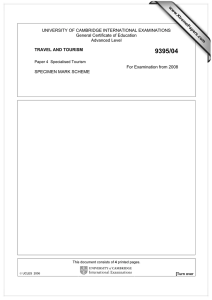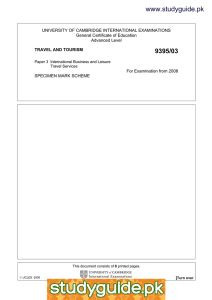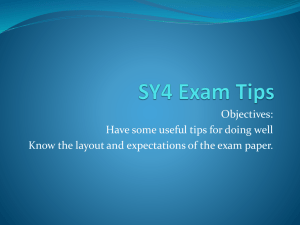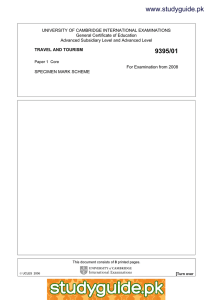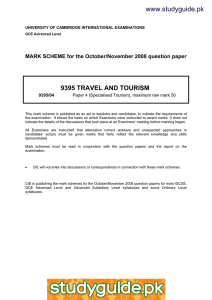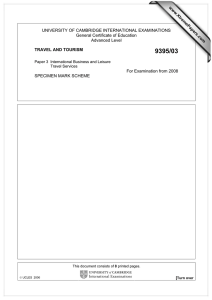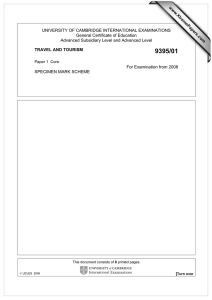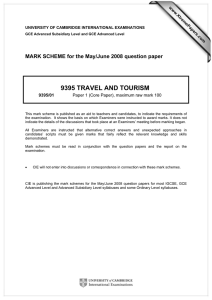www.studyguide.pk
advertisement
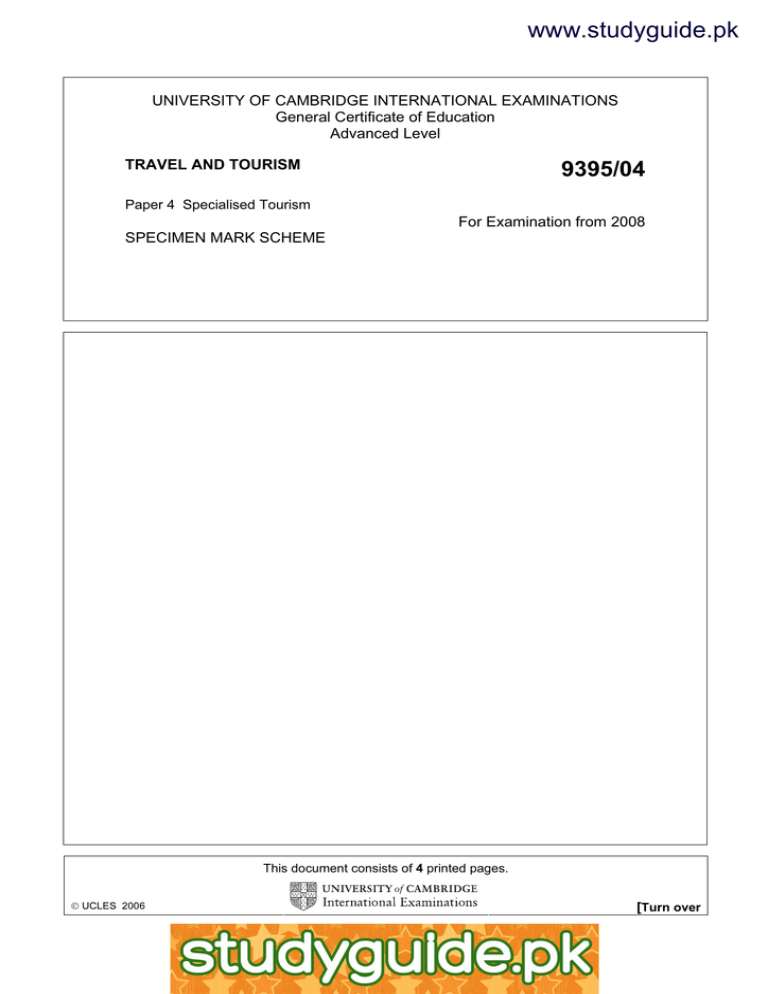
www.studyguide.pk UNIVERSITY OF CAMBRIDGE INTERNATIONAL EXAMINATIONS General Certificate of Education Advanced Level 9395/04 TRAVEL AND TOURISM Paper 4 Specialised Tourism For Examination from 2008 SPECIMEN MARK SCHEME This document consists of 4 printed pages. UCLES 2006 [Turn over www.xtremepapers.net www.studyguide.pk 2 Q. No. 1 (a) Expected Answer Mark Focus State three examples of handicraft items being used for 3 4.1 “the promotion of the host destination”. 4.2 Award as: • • • • (b) one mark for each of three valid identifications such Boomerang/Australia Rastafarian items/Jamaica Aztec items/Mexico Carpets/Middle East Credit all appropriate examples. Explain three ways in which a strong handicraft sector 6 can bring about positive social and economic benefits within destinations. 4.1 Credit all valid reasoning. Outline two reasons why ‘all-inclusive’ resorts tend to 4 have a negative effect on the handicraft sector. Award one mark for each of two valid reason identifications and then a further one mark for each if appropriately expanded. Correct ideas will include: • Resorts privately run and managed (1) – difficult for locals to supply (1) • Guests tend to stay inside (1) – limited spending outside resort (1) • Locals cannot enter freely (1) – limits opportunity to sell (1) Credit all valid reasoning. © UCLES 2006 9395/04/SP08 www.xtremepapers.net AO2 (3) AO3 (3) Award one mark for each of three valid identifications and then a further one mark for each if appropriately explained. Correct ideas based on Fig. 1 will include: • Job creation (1) – helps reduce underemployment (1) • Foreign exchange (1) – increased GDP (1) • Poverty alleviation (1) – increased incomes (1) • Support vulnerable communities (1) – improved standard of living (1) (c) AO AO1 4.1 AO1 (2) AO2 (2) www.studyguide.pk 3 (d) With reference to at least one example with which you 12 are familiar, discuss how ecotourism projects encourage sustainable tourism. 4.1 AO1 (4) AO3 (4) AO4 (4) 4.3 AO2 4.3 AO2 Use level of response criteria Candidates are expected to must have made a study of at least one ecotourism project and be fully familiar with: • aims and objectives of the project; • features of the project; • organisations involved in the management of the project; • effectiveness of the project in environmental, social and cultural terms; • significance of planning and education to sustain the future management of the project; • an analysis of the effectiveness of the project, in terms of visitor numbers and local, national or international involvement. Level 1 (1-4 marks) will be descriptive of the project’s features but will not focus on the sustainability issue. Level 2 (5-8 marks) will analyse at least one aspect of the project in terms of sustainability and better answers will discuss more than one. 2 (a) (b) Level 3 (9-12 marks) will have a clear evaluation of the project in sustainable terms and we should expect some conclusion about the scheme’s operation in the future. Identify the adventure tourism activity shown in each 3 of Photos A, B and C. Award one mark for each as follows: Photo A = Walking (allow rambling etc.) Photo B = Canoeing Photo C = Ghyll Scrambling (allow river walk) With reference to Photo A, state one likely visitor 4 environmental impact and explain how this impact has been managed. This requires the candidate to interpret the image to identify an impact and then look for evidence as to how it has/might be minimised. Award one mark for impact identification and a further mark if a description is offered. Award one mark for an appropriate solution and a further one mark if valid comment is made. The most likely response will include: Footpath erosion (1) – too many walkers wear the land away (1) – the paths are repaired (1) using resistant materials (1) © UCLES 2006 9395/01/SP08 www.xtremepapers.net [Turn over www.studyguide.pk 4 (c) Discuss how some outdoor activities may create 6 negative impacts on other visitor groups. 4.3 AO1 (2) AO3 (2) AO4 (2) 4.1 4.2 4.3 AO1 (2) Use level of response criteria The negative impacts can be a source of conflict, not with locals, but with other visitors. This is very appropriate for destinations such as the Lake District and we should be quick to reward candidates who offer valid illustrations. Level 1 (1-2 marks) will be descriptive of uses but thin on the nature of the impact(s) Level 2 (3-4 marks) will look at two impacts and clearly state how one activity effects others e.g. speed boats affect fishing on lakeshore – swash and fish. (d) Level 3 (5-6 marks) will look at two or more impacts providing clear and accurate detail about what is involved. We should expect evaluative comment leading to a conclusion. Assess the extent to which many adventure activities 12 take place in fragile environments and amongst people whose culture and traditions are different to that of the tourist. This idea is taken directly from the syllabus and we should expect candidates to be able to think of a range of contexts and examples. There are two aspects to this and we should expect Level 3 answers to comment on both: • Fragile environments • Local culture and traditions Use level of response criteria Level 1 (1-4 marks) will be descriptive of activities and lack much focus on environment and/or locals. Level 2 (5-8 marks) will clearly attempt an analysis of 1 or 2 adventure activity’s effects on either the environment and/or locals Level 3 (9-12 marks) will offer clear evaluation of at least one activity’s effects on an identifiable environment and specific local culture and traditions. We should expect a valid reasoned conclusion. © UCLES 2006 9395/04/SP08 www.xtremepapers.net AO2 (2) AO3 (4) AO4 (4)
